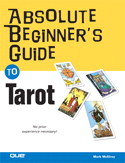|
Tarot Reflections |
May 2006 |
| Review: Absolute Beginner's Guide to Tarot Sandra Thomson, CTGM |
|||||||
|
While most of the book is taken up with discussing the meanings of the cards, the five Section One chapters ("Getting Started with Tarot") guide the beginner through the benefits of working with the Tarot and what is has to offer, a brief history of Tarot (more accurate than many other contemporary Tarot books), basics of buying and caring for a deck, and how to prepare for and perform readings. If you are somewhere beyond being a beginner, you likely will want to own this book as a reference or a reminder. It may even contain ideas you have not considered for McElroy is one of the most creative and versatile of contemporary writers on the Tarot. Illustrations from four decks (the Universal Tarot, the gorgeous Gilded Tarot, Mark's own Bright Idea Deck, and the Tarot of Marseilles) accompany the discussions of each card. If you have never seen a copy of The Bright Idea Deck, or don't own it, you may want to after using this book for a while. You may also want to dig out your old Tarot of Marseilles and look at it in a new way after using the book. Major subcategories for each card include an "Overview," which offers keywords, light and shadow meanings, correspondences (numerology, astrology, affirmation, and story aspects) and "Advice," divided into ways of considering the card with respect to relationships, work, spirituality, personal growth, fortunetelling and timing opportunities. "Symbols and Insights" briefly (alas, all too briefly but enough to be provocative) discusses one symbol on the card, and the section for each card ends with three "Questions to Ask" when you draw that card. Whether or not you agree with McElroy's understanding of the cards, you cannot fail to consider some new aspect of your relationship with yourself, or another, as you ponder his writing about each card. Let's look at how this plays out in one card. I shuffled and cut my Rider-Waite-Smith deck and turned over the top card, the Three of Cups, a favorite of many people. While I cannot reproduce everything McElroy has to say about it, I will remark on some relatively well-known concepts and possibly some that will be provocative for you. Keywords for the Three of Cups are celebration, expression, community, and friendliness. Its light meaning suggests celebrating your feelings, expressing joy, and several other ideas. The shadow meaning includes mistaking giddiness for true affection, demanding unreasonable support, being dominated by manic emotions, and partying to a dangerous or unhealthy extent. Have you ever considered that? Some of McElroy's advice for relationships include the idea that actions speak louder than words and asks the question, "What service can you render as a way of showing your love?" With respect to work he says that if our schedules are dominated by things we don't love doing, it might be time to reorganize our priorities. Ask how you - and others - manage your time. For spirituality, McElroy reminds us that it is easy to neglect rituals that are an integral part of living with spirit and that you may need to become a part of a like-minded group. Finally, in considering the card with respect to personal growth he says you need to look for opportunities to serve others or aid them in their pursuits and offers the view that shared success is sweeter. With respect to fortune-telling and time wise, McElroy writes that an unconventional romance is coming your way between July 2 and 11. Those of you who know me know that fortune-telling is the last possible way I would use the cards - and the least useful, even silliest, aspect of this book for me - but you can play with it and check it out for yourself. Who knows? One of the most interesting things for me is the way McElroy discusses the pip images on the Tarot of Marseilles cards. Many people avoid this deck because, well, what is there to say about three (or more) pips other than "there they are," and utilizing a memorized meaning? If you're Mark McElroy, however, you look at the card's image. "The blossom seen on the Two of Cups has matured into a third cup: the offspring of the original pair. What fruit is being produced by your own spiritual work or emotional involvement?" Well, you knew that was how to interpret this card, didn't you? Of course you did. Finally, the questions to ask when you draw this card include asking what's worth celebrating in your life, what you can do to show your partner (I would add "others" as well) how you really feel, and consider how you can demonstrate your feelings in an appropriate way. Almost every Tarot book includes spreads and this one is no different, showing two- , three- , and five-card spreads, as well as the old tried-and-true Celtic Cross spread, which I think is a positive horror for beginners, but I suppose must be included to make the book complete. Most intriguing is the five-card Story Spread, designed to transform your situation into a story, presumably making it easier for you to understand the "flow of events that give rise to your situation." Without going into detail about each position, I will say that briefly the positions include Once Upon a Time, The Incident, Initial Response, Insight, and Resolution. McElroy thinks this spread particularly effective for working with relationship issues "because it clarifies original intentions, identifies misunderstood or misinterpreted actions, and suggests a way to move forward." McElroy closes the book with a chapter on 13 fun things you can do with the cards - and far be it for me to give away the fun - plus a chapter on where to go to learn more (books, decks, online resources, and software). The extensive index allows you to find absolutely (sorry, just can't help myself) anything you want to know. The Absolute Beginner's Guide to Tarot (0-7897-3515-6) is published by Que, 800 East 96th St., Indianapolis, Indiana 46240, and available at bookstores and Amazon.Com. |
||||||
|
|
|||||||
|
Subscribe to Tarot Reflections, and receive notification of each update! |
|
Request to be added to the list by sending email to TarotReflections-subscribe@yahoogroups.com! |
All articles remain the
property of their respective authors.
Tarot Reflections is a publication of the American Tarot Association
- Copyright (C) 2006
Questions or Comments? Contact Us.


